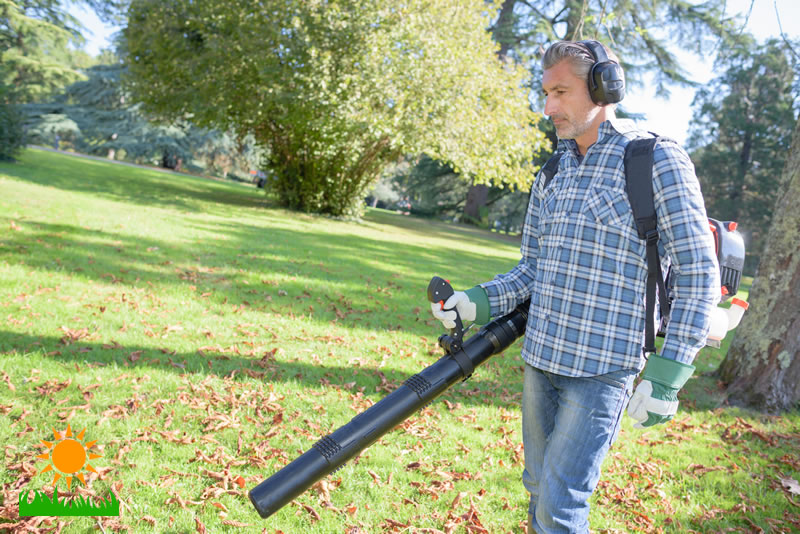Fall is the time of year when people love to see the changing colors of the leaves, feel the crispness in the air, and hear the crunch of fallen leaves beneath their feet. Children especially enjoy the opportunity to jump into big piles of leaves and roll in the autumn grass.

But for us homeowners, leaves are less magical and more annoying, leaving us with lots of clean-up and constant maintenance of our houses and flower beds. Enter the ubiquitous leaf blower, that handy remover of refuse, and cleaner of clutter!
If you’re thinking of getting one or own one already, our Leaf Blower How-To Guide will help you discover what options are available, how to use it, and safety tips and videos to ensure you get it right the first time.
What is a Leaf Blower?
If you have ever raked leaves by hand, you have, no doubt, yearned for a better way. Raking leaves can be back breaking work and the rake can leave blisters on your hands from repetitive use.
Leaf blowers were created to eliminate all that. Logically, if the wind blew them into your yard, why not use wind to move them out?
Quite simply, a leaf blower is a motorized garden tool that propels air out of a nozzle to move grass clippings, yard debris, and, well, leaves into a pile for removal.
Different Kinds of Leaf Blowers
There are several different kinds of leaf blowers. There are gas powered and electric units; there are handheld models, backpack models, and even push units like lawn mowers. But which kind would be best for you?
To answer that, you need to determine how you will most often use your blower; what kinds of tasks will you use it for?
If you just need it to help clear your yard in the fall, and your yard is not too big, you could use a hand-carried electric model. If you are a lawn care professional or have a large yard that you like to have meticulously maintained, you may want a heavy-duty gas-powered backpack unit.
Ideas (How-to) for Using Your Leaf Blower
Here are some ideas for using your blower that may help you decide which one is right for you.
Clear Hard to Reach Places:
If you have areas that are difficult to reach by hand or with a rake, like steps off a deck or around an air conditioner, a blower can clear leaves from these places much more efficiently, and save your back by not requiring you to bend over to do it.
Clean Up More Than Leaves:
Blowers can be used to clear other things besides leaves, such as grass from a sidewalk, cups from under picnic tables, and dust and dirt from under workbenches in a shop area. They can even clear light snow from porches and walkways.
Clean Up Inside Too
Some electric models can be used inside to clear air ducts or in the garage to blast dust from your car’s engine. A leaf blower can be an all-in-one machine, making it well worth the investment.
Leaf-Blower Safety Tips
Whatever way you choose to use your blower, it is important that you do so in a safe and responsible way. Here’s what you can do:
Protect Your Eyes:
Always wear eye protection, as these blowers can move air at over 200 mph, which is category 5 hurricane force wind! Even though you are blowing away from you, sometimes debris can hit a wall or tree and bounce back towards you at high speed, so wear protective clothing with long sleeves.
Cover Your Ears:
It is also advisable to wear ear protection, as these units are noisy and you will be running them for some length of time.
Keep Your Airways Clear:
I have also found that I like to wear a respirator or safety mask because they can stir up a lot of dust in the air, and if you are allergic to trees or pollen, you don’t want to breathe in those particulates.
Here’s a video on how to use a leaf blower:
How to Maintain Your Leaf Blower
In order to keep your blower running at top efficiency, you will need to do some routine maintenance. Here are some helpful tips:
Here is a helpful video on Gas Leaf Blower Maintenance produced by Echo, a maker of a variety of blowers: https://www.youtube.com/watch?v=eLaqNBCqr0Q
Be Clean
Probably the most important rule, whether it is gas or electric is keeping the unit clean. Blowing a high volume of air at that velocity will stir up all kinds of dust and debris, and if it builds up on the surface of your unit, or especially in the moving parts, it can cause damage and even prevent the unit from working at all.
When you finish your daily task, remove the long nozzle and you can either blow it off with the blower or rinse it off with a garden hose. Clean off all the exterior surfaces and any places where dust and dirt may collect. You also want to get as much dust out of the motor as possible.
With an electric motor, you can wipe it off or use compressed air to blow it out. A gas motor presents a few more challenges but is still pretty easy to maintain.
Check it Top to Bottom
There is even an article on using twin leaf blowers to supercharge a corvette! (yes, really!)
All in all, leaf blowers are a huge modern convenience, and when used properly, can save hours of back-breaking work and can make your yard look fantastic. I hope this Leaf Blower How-To Guide told you everything you need to know
